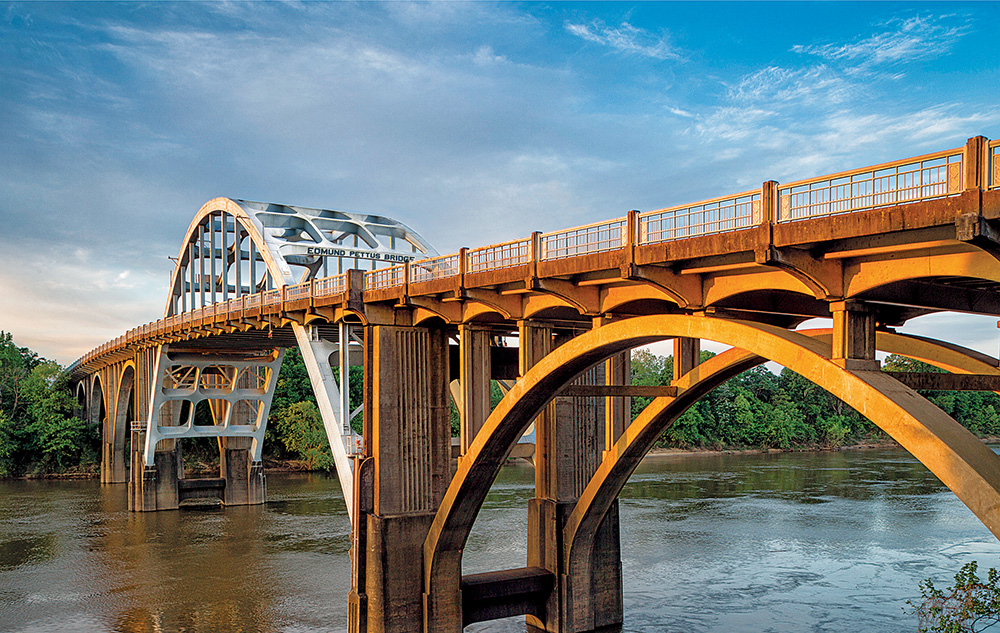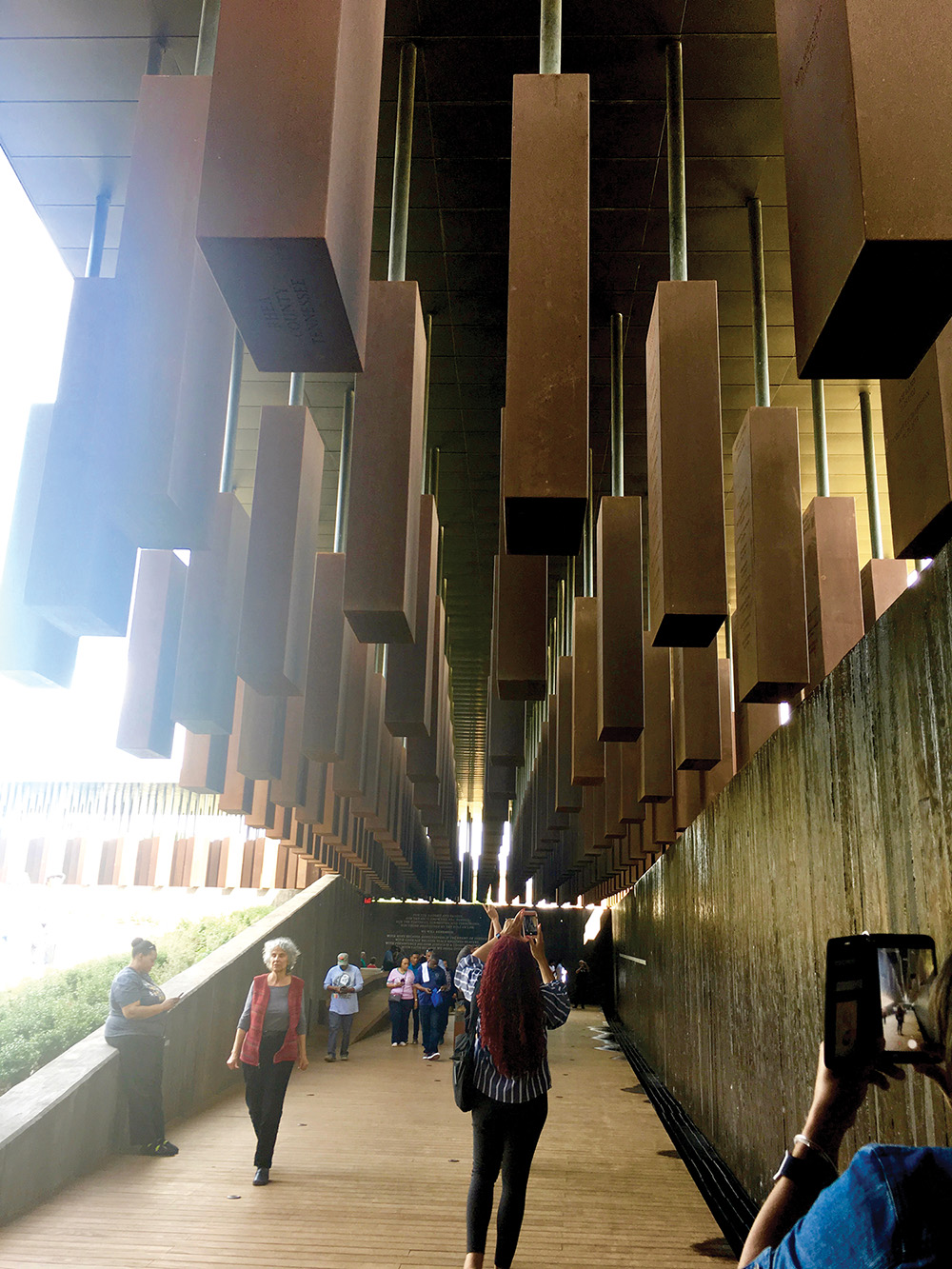
Visitors can literally walk in the footsteps of Martin Luther King Jr., Rosa Parks, Medgar Evers, John Lewis and other African-American activists, thanks to the U.S. Civil Rights Trail that launched earlier this year on King’s birthday.
Southern tourism departments have curated a list of more than 100 museums, churches, courthouses and other landmarks pivotal to the advancement of social equality during the volatile 1950s and 1960s.
Famous sites such as the Edmund Pettus Bridge in Selma; Little Rock Central High School in Arkansas; the Greensboro, N.C., Woolworth’s, where sit-ins began; the National Civil Rights Museum at the Lorraine Motel in Memphis, Tenn.; and Dr. King’s birthplace in Atlanta are anchors.
“Two years ago when National Park Service Director Jonathan Jarvis challenged historians to inventory surviving civil rights landmarks, Georgia State University found 60, which became the foundation of the trail,” says Alabama Tourism Director Lee Sentell. (Read an interview with Sentell on Page 26.) The 12 state tourism agencies known collectively as Travel South USA supplemented the list with other worthy sites.
“We feel that the trail will encourage Americans to better understand their history,” says Travel South’s president, Liz Bittner. Several major international tour operators have added civil rights destinations since the concept was previewed in London several months ago, she adds.
The website civilrightstrail.com profiles the landmarks and offers an interactive map, interviews with foot soldiers, past and present photographs, and 360-degree video as special features.
The trail stretches from schools in Topeka, Kansas, known for the Brown v. Board of Education desegregation court decision in 1954, to the Lincoln Memorial in Washington, D.C., where King delivered his “I have A Dream” speech in 1963.
Places where blacks died at the hands of opponents to desegregation are scattered across the Deep South. The courthouse in Sumner, Miss., where two white men accused of murdering 14-year-old Emmett Till walked free in 1955, has been restored, as has the home where voting-rights activist Medgar Evers was assassinated in 1963 in Jackson, Miss., hours after President John Kennedy proposed major civil rights legislation.
Also on the trail is the 16th Street Baptist Church in Birmingham, where four girls died in a Sunday morning bombing in 1963 after federal courts ordered local schools integrated. It remains an active church.
Lesser known sites include the birthplace of Whitney Young in Simpsonville, Ky.; the Elizabeth Harden Gilmore House in Charleston, W.V.; and Moton High School in Farmville, Va. Sixteen-year-old Barbara Johns organized a school strike there in 1951 demanding facilities equal to those of whites, which generated a lawsuit that was consolidated into the Topeka case.
Several sites predate the modern civil rights era, notably St. Louis’s Old Courthouse, where the Dred Scott case originated; the historic Tremé neighborhood in New Orleans; and museums for the Scottsboro Boys and the Tuskegee Airmen, both in Alabama.
Heritage tourists can learn about King at numerous locations in Atlanta, including Ebenezer Baptist Church, his birthplace, the site of his interment at the King Center founded by Coretta Scott King, and the National Center for Civil and Human Rights. King’s first church, Dexter Avenue King Memorial Baptist, where the bus boycott was organized in 1955, and its parsonage in Montgomery are must-visit sites on any civil rights tour.
King’s most famous quotes are linked to specific sites. When he was arrested during the 1963 Easter shopping boycott, he wrote in his “Letter From Birmingham Jail” that “injustice anywhere is a threat to justice everywhere.” At the end of the Selma-to-Montgomery March, he famously said, “How long? Not long, because the arc of the moral universe is long, but it bends toward justice.” The night before his death in Memphis, he said at the Mason Temple Church of God in Christ, “I’ve seen the Promised Land. I may not get there with you. But I want you to know tonight, that we, as a people, will get to the Promised Land.”

The National Civil Rights Museum at the Lorraine Motel in Memphis re-creates large-scale scenes of notable events of the movement and details the 1968 assassination of King. This museum is recommended, as are five others, including the International Civil Rights Museum in the former Greensboro Woolworth’s.
U.S. Rep. John Lewis of Georgia labored more than 16 years to fund and establish the National Museum of African American History and Culture, which opened to wide acclaim a year ago in Washington, D.C. The Birmingham Civil Rights Institute, which houses the door to King’s former jail cell, faces the park where fire hoses and dogs were used to terrorize youthful protesters in 1963.
Jackson hosts the new Mississippi Civil Rights Museum, the only one sponsored by a state. Small theaters inside recount the stories of Emmett Till and Medgar Evers. Many of King’s papers are collected at Atlanta’s National Center for Civil and Human Rights.
The website civilrightstrail.com offers 360-degree video of landmarks in Memphis, Little Rock, Birmingham, Washington, Atlanta, Topeka, Selma and Montgomery. The website also allows visitors to compare historic photographs with current views of the same scenes in Memphis, Little Rock, Selma, Birmingham, Montgomery, Topeka and Greensboro.
Veteran foot soldiers recount their experiences from a half-century ago on video. Bruce Boynton discusses his 1958 arrest in a Richmond, Virginia, bus station that led to the Freedom Rides in 1961, and Bernard LaFayette Jr., the roommate of rides organizer John Lewis, recalls being attacked and beaten at the bus station in Montgomery.
The Rev. Arthur Price Jr. talks about the history of 16th Street Baptist Church in Birmingham, and tour guide Wanda Howard Battle sings inside Dexter Avenue King Memorial Baptist Church in Montgomery. (Battle’s talk to Montgomery Youth Tour participants is one of the most popular parts of MYT each year.)
The people, locations and destinations included in the Civil Rights Trail provide a way for families, travelers and educators to experience history firsthand and tell the story of how “what happened here changed the world.”
For more information, or to begin your journey on the trail, please visit civilrightstrail.com. Article courtesy of the U.S. Civil Rights Trail.
A new memorial dedicated to the victims of lynching and racial terror opened in April in Montgomery, to national acclaim and attention.
The National Memorial for Peace and Justice, which confronts a disturbing period in American history, is the nation’s first memorial dedicated to the legacy of enslaved black people and those terrorized by lynching and racial segregation.
The memorial was conceived and built by the Equal Justice Initiative, a legal advocacy organization in Montgomery, and grew out of the EJI’s exhaustive research into thousands of racial terror lynchings.
A companion to the memorial is the Legacy Museum: From Enslavement to Mass Incarceration, which dramatizes the enslavement of African Americans and depicts the evolution of racial terror lynchings.
The museum is located at 115 Coosa St.; the memorial is at 417 Caroline St. For more information on both, visit museumandmemorial.eji.org





